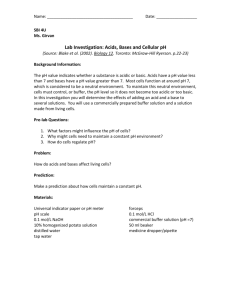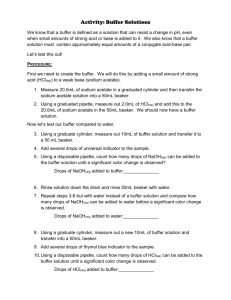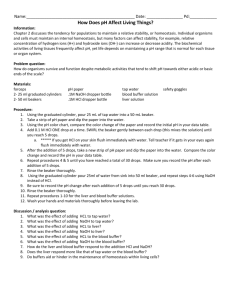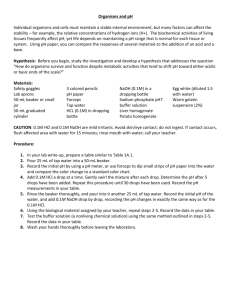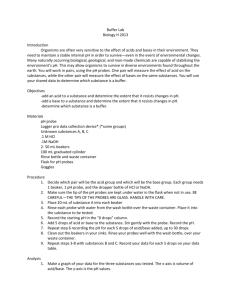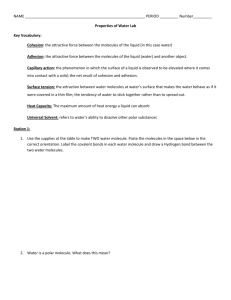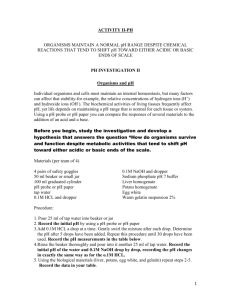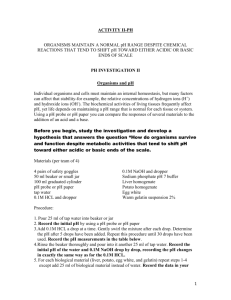Lab6_121Buffers_jpedits
advertisement
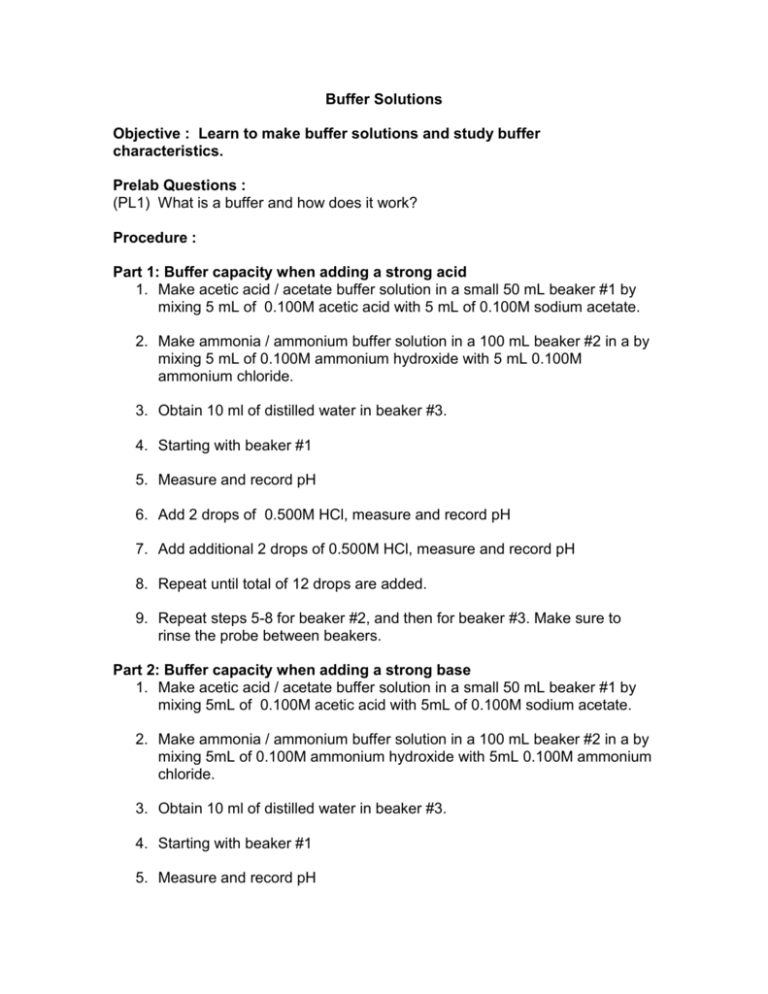
Buffer Solutions Objective : Learn to make buffer solutions and study buffer characteristics. Prelab Questions : (PL1) What is a buffer and how does it work? Procedure : Part 1: Buffer capacity when adding a strong acid 1. Make acetic acid / acetate buffer solution in a small 50 mL beaker #1 by mixing 5 mL of 0.100M acetic acid with 5 mL of 0.100M sodium acetate. 2. Make ammonia / ammonium buffer solution in a 100 mL beaker #2 in a by mixing 5 mL of 0.100M ammonium hydroxide with 5 mL 0.100M ammonium chloride. 3. Obtain 10 ml of distilled water in beaker #3. 4. Starting with beaker #1 5. Measure and record pH 6. Add 2 drops of 0.500M HCl, measure and record pH 7. Add additional 2 drops of 0.500M HCl, measure and record pH 8. Repeat until total of 12 drops are added. 9. Repeat steps 5-8 for beaker #2, and then for beaker #3. Make sure to rinse the probe between beakers. Part 2: Buffer capacity when adding a strong base 1. Make acetic acid / acetate buffer solution in a small 50 mL beaker #1 by mixing 5mL of 0.100M acetic acid with 5mL of 0.100M sodium acetate. 2. Make ammonia / ammonium buffer solution in a 100 mL beaker #2 in a by mixing 5mL of 0.100M ammonium hydroxide with 5mL 0.100M ammonium chloride. 3. Obtain 10 ml of distilled water in beaker #3. 4. Starting with beaker #1 5. Measure and record pH 6. Add 2 drops of 0.500M NaOH, measure and record pH 7. Add additional 2 drops of 0.500M NaOH, measure and record pH 8. Repeat until total of 12 drops are added. 9. Repeate 6-8 for beaker 2, and then for beaker 3. Make sure to rinse the probe between beakers. Lab Report Guide: - 1. Results o Tables neatly filled out with data o Proper significant figures for pH o Plot the pH (y-axis) versus drops of NaOH added (x-axis), for each beaker 1-3. o Plot the pH (y-axis) versus drops of HCl added (x-axis), for each beaker 1-3. - 2. Error Analysis o Typed brief discussion comparing the three buffer solutions. Describe possible sources of error. Note that “human error” is not an acceptable answer. Please be specific. - 3. Post Lab Questions o Typed answers to the Post Lab questions. Note that single sentence answers will not suffice. State the answer to the question followed by a brief description of the evidence supporting that answer. Data Tables: Drops of HCl added pH Beaker 1 Acetic Acid pH Beaker 2 Ammonia pH Beaker 3 Water pH Beaker 1 Acetic Acid pH Beaker 2 Ammonia pH Beaker 3 Water 0 drops Drops of NaOH added 0 drops Post lab Questions: (Q1) According to your graphed data is one buffer (beaker 1-3) better or worse than the other(s)? Explain. (Q2) Write out the chemical reaction that occurs in the Acetic Acid / Acetate buffer when a. NaOH is added b. HCl is added (Q3) Write out the chemical reaction that occurs in the Ammonia/Ammonium buffer when a. NaOH is added b. HCl is added (Q4) Write out the chemical reaction that occurs in the Distilled water when a. NaOH is added b. HCl is added (Q5) Does distilled water make a good buffer? Why or why not? (Q6) How can you tell if the buffer is working? (Q7) What happens when you go beyond the buffer capacity? How is buffer capacity indicated on your graph(s)?
